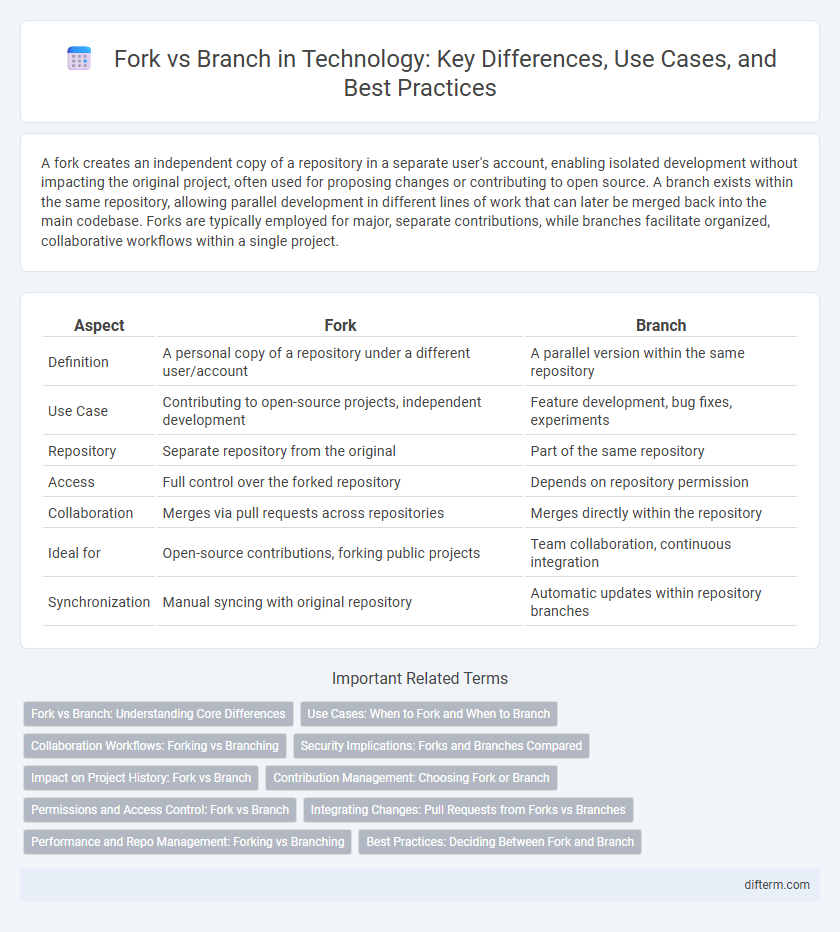A fork creates an independent copy of a repository in a separate user's account, enabling isolated development without impacting the original project, often used for proposing changes or contributing to open source. A branch exists within the same repository, allowing parallel development in different lines of work that can later be merged back into the main codebase. Forks are typically employed for major, separate contributions, while branches facilitate organized, collaborative workflows within a single project.
Table of Comparison
| Aspect | Fork | Branch |
|---|---|---|
| Definition | A personal copy of a repository under a different user/account | A parallel version within the same repository |
| Use Case | Contributing to open-source projects, independent development | Feature development, bug fixes, experiments |
| Repository | Separate repository from the original | Part of the same repository |
| Access | Full control over the forked repository | Depends on repository permission |
| Collaboration | Merges via pull requests across repositories | Merges directly within the repository |
| Ideal for | Open-source contributions, forking public projects | Team collaboration, continuous integration |
| Synchronization | Manual syncing with original repository | Automatic updates within repository branches |
Fork vs Branch: Understanding Core Differences
Forks create a complete copy of a repository under a different user's account, enabling independent development without affecting the original project, ideal for open-source contributions and major changes. Branches exist within the same repository, allowing multiple parallel versions of the code to evolve simultaneously while maintaining centralized control and easier integration. Understanding these core differences helps developers decide when to isolate work through forks or collaborate closely via branches for efficient version control.
Use Cases: When to Fork and When to Branch
Forking is ideal for contributing to open-source projects where users need an isolated copy to experiment without affecting the original repository, enabling independent development. Branching suits collaborative workflows within the same repository, allowing multiple developers to work on features, bug fixes, or experiments concurrently while maintaining a shared codebase. Teams commonly branch to manage stages of development like feature integration and testing, reserving forks for significant divergences or when external contributors lack direct write access.
Collaboration Workflows: Forking vs Branching
Forking creates an independent copy of a repository, enabling isolated contributions without affecting the original project, ideal for open-source collaboration. Branching allows multiple developers to work simultaneously within the same repository, facilitating seamless integration and continuous workflow management. Understanding the differences in collaboration workflows helps teams optimize project management and maintain code integrity.
Security Implications: Forks and Branches Compared
Forks create isolated copies of repositories, allowing developers to experiment without affecting the original codebase, which enhances security by containing potential vulnerabilities. Branches exist within the same repository, making them more susceptible to accidental exposure of sensitive information or unvetted code changes. Proper management and permissions are crucial in branches to mitigate security risks, whereas forks inherently provide a safety buffer by separating development environments.
Impact on Project History: Fork vs Branch
Forking creates a separate copy of the entire repository, allowing independent development that does not alter the original project's commit history, which helps maintain a clean and linear history in the main repository. Branching works within the same repository, integrating changes directly into the project's history, preserving commit relationships and enabling easier tracking of feature development and bug fixes. Choosing between fork and branch affects collaboration workflows, access control, and the overall clarity of the project's version history in platforms like GitHub and GitLab.
Contribution Management: Choosing Fork or Branch
Forks create independent repositories allowing contributors to propose changes without affecting the original codebase, ideal for managing external or large-scale contributions. Branches operate within the same repository, enabling streamlined collaboration and easier integration for teams working closely on the same project. Selecting between fork and branch depends on the scope of contribution and the desired workflow control within version control systems like Git.
Permissions and Access Control: Fork vs Branch
Forks create independent copies of repositories, granting users full control and permissions over their version without affecting the original project. Branches, however, reside within the main repository, requiring contributors to have write access and subjecting them to the repository's access control policies. Forking supports open collaboration by allowing external contributors to propose changes via pull requests, whereas branching facilitates internal development under stricter permission management.
Integrating Changes: Pull Requests from Forks vs Branches
Pull requests from branches enable seamless integration within the same repository, facilitating direct collaboration and streamlined code review processes. Fork-based pull requests introduce an additional layer by requiring changes to be merged across separate repositories, enhancing security but potentially complicating synchronization. Choosing between forks and branches depends on project governance, with branches favored for internal teams and forks preferred for open-source contributions.
Performance and Repo Management: Forking vs Branching
Forking creates a separate copy of the entire repository, allowing isolated development and independent performance without affecting the main project. Branching operates within the same repository, enabling seamless context switching and more efficient version control, which enhances collaboration and minimizes duplication of data. Managing forks can increase overhead due to synchronization requirements, while branches streamline repo management by maintaining a unified project history.
Best Practices: Deciding Between Fork and Branch
When managing code in collaborative software development, best practices recommend using branches for small, incremental changes within the same repository to maintain streamlined integration and continuous delivery. Forks are preferred for larger, independent projects or contributions from external collaborators, enabling isolated development environments without affecting the main codebase. Choosing between fork and branch hinges on project scope, team collaboration style, and access permissions to ensure efficient version control and code review processes.
fork vs branch Infographic

 difterm.com
difterm.com